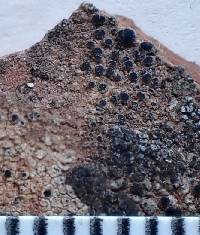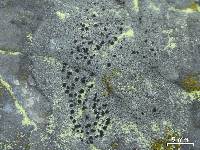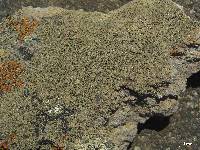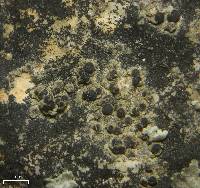
Consortium of Lichen Herbaria
- building a Global Consortium of Bryophytes and Lichens as keystones of cryptobiotic communities -
- Home
- Search
- Images
- Species Checklists
- US States: O-Z >
- US National Parks
- Central America
- South America
- US National Parks
- Southern Subpolar Region
|
|
|
|
Family: Ramalinaceae
[Callopisma genevense Müll.Arg., moreCandelariella genevensis (Müll. Arg.) M. Choisy, Lecania genevensis (Müll. Arg.) Lettau, Lecaniella polycycla (Anzi) Jatta, Lecanora genevensis (Müll.Arg.) Stizenb., Rinodina polycycla Anzi] |
Nash, T.H., Ryan, B.D., Gries, C., Bungartz, F., (eds.) 2004. Lichen Flora of the Greater Sonoran Desert Region. Vol 2. Thallus: crustose, granular or rimose to areolate, rimulose-areolate, sometimes leprose-like, suborbicular, thin, to 0.2 (-0.25) mm thick; prothallus: sometimes present, dark brownish-black areoles: angular, plane, contiguous, c. 0.5 mm across surface: gray-brown to olive-brown or green-black, tartareous, not discolored when wet, with concolorous edges, dull, epruinose cortex: indistinct, the upper 5-10 µm pale red-brown, overall 10-20 µm thick, lacking an epinecral layer medulla: not developed; algal layer: with algae filling the thallus and reaching almost to the surface in places Apothecia: adnate, crowded in thallus center, broadly sessile, in small groups, up to 0.6 mm in diam. discs: dark brown to black, paler when wet (red-brown to orange-brown), plane to slightly convex, epruinose, unchanged when wet margin: whitish gray, or light gray to yellowish-brown, distinct but not swollen, sometimes cracked, level with disc, finally crowded back amphithecium: with a narrow, distinct cortical zone parathecium: often present, prosoplectencymatous, hyphae, in the upper part with dark cell walls; hypothecium: hyaline, hyphae intricate epihymenium: medium to dark brown, rarely greenish, composed of pigmented paraphyses tips, epipsamma sparse hymenium: hyaline below, 40-55 µm; paraphyses: +free in water, simple or sometimes branched, 1.5-2 µm wide below, apically strongly capitate or clavate, 4-8 µm wide, with brown granules and cap-like covering of dark brown pigment on the outer cell wall; hypothecium: hyaline asci: clavate, Bacidia-type, 40-45 x 10 µm, 8-spored ascospores: hyaline, 1-septate, ellipsoid-oblong, often slightly constricted in the middle, 8.5-12 x 4.5-5.5 µm, thin-walled Pycnidia: immersed, 50150 µm in diam.; wall: hyaline, brown near ostiole; conidiogenous cells: branched at base, elongate, cyilindical, 8-15 x 2-2.5 µm conidia: filiform, strongly curved, 14-19 x Spot tests: all negative Secondary metabolites: none detected. Substrate and ecology: on calcareous rocks, rarely on acidic rocks World distribution: widely distributed throughout central to southwestern Europe, northern Africa and southwestern North America Sonoran distribution: central Arizona (Gila Co.). Notes: The constricted ascospores and free paraphyses readily distinguish Lecania polycycla from any other Lecania in the Sonoran region. Sonoran material differs somewhat from European material in that the paraphyses are less often branched at apices. Lecania polycycla differs from L. ochronigra, a saxicolous species from Iran, by the lack of pruina on the apothecia. This latter species has a bright yellowish to reddish ochraceous thallus. In the field, L. polycycla is easily overlooked for diminuitive L. rabenhorstii or even a Rinodina or Catillaria species. |
Powered by Symbiota




















